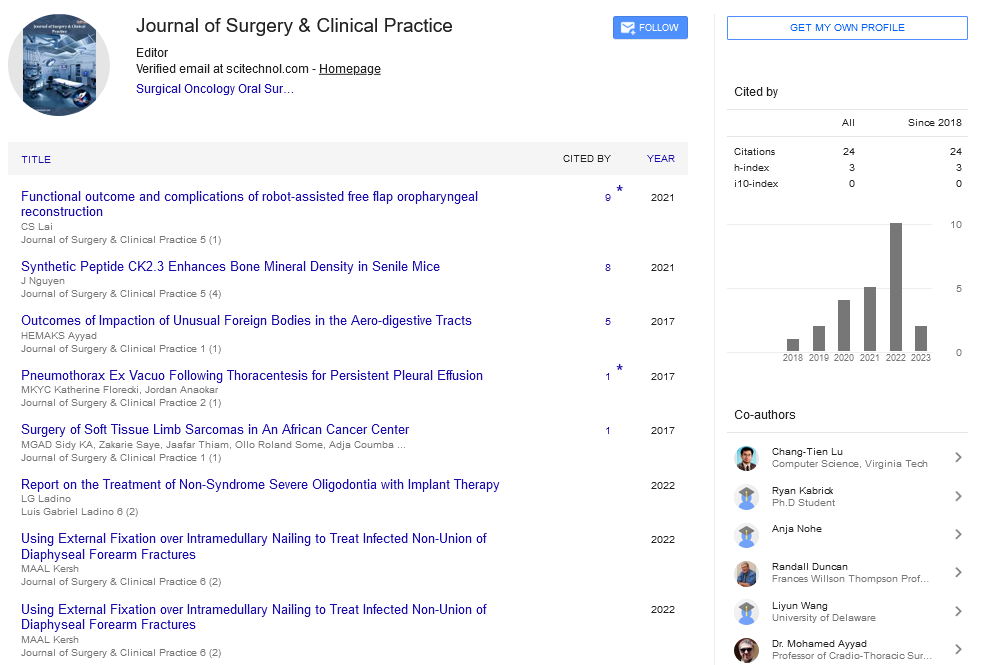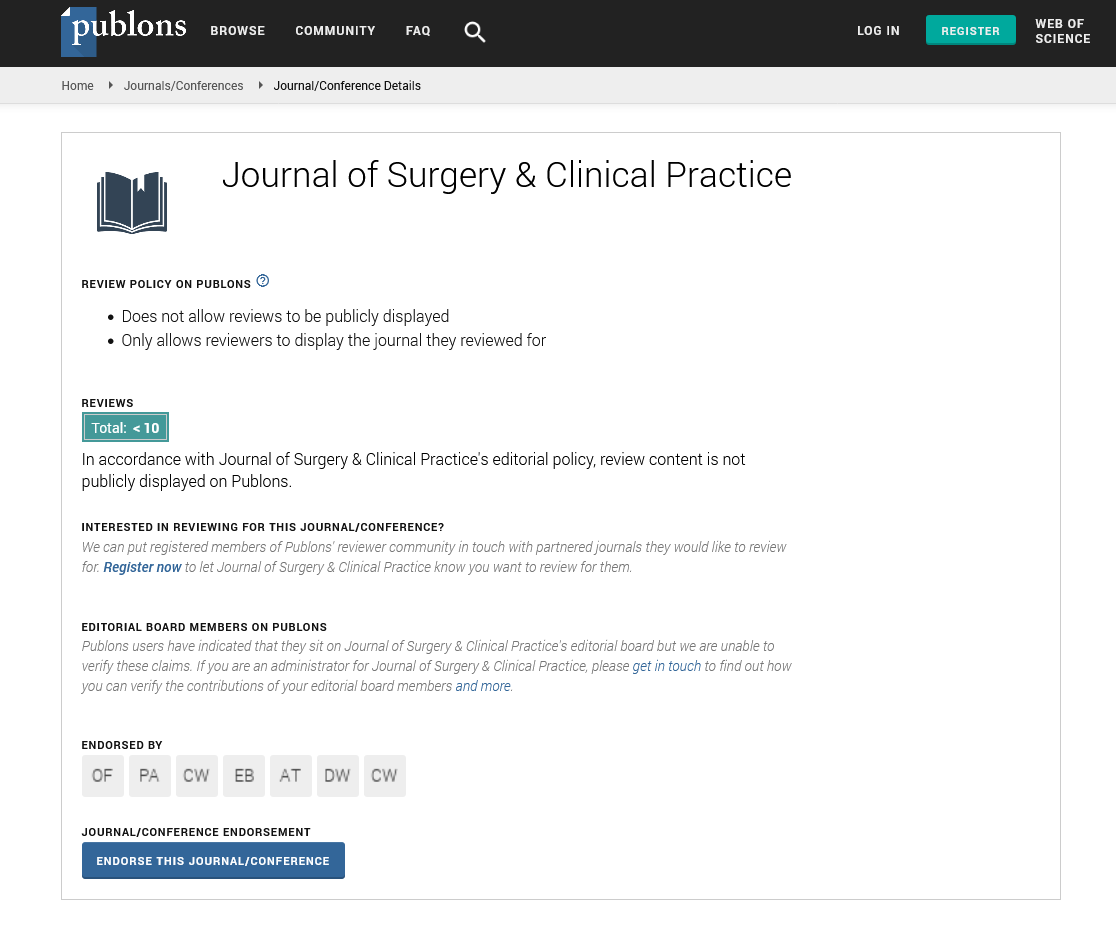Short Communication, J Surg Clin Prac Vol: 7 Issue: 3
Neurosurgical Innovations in Chronic Pain Management
Chady Atallah*
1Department of Surgery, The Johns Hopkins University School of Medicine, Baltimore, USA
*Corresponding Author: Chady Atallah,
Department of Surgery, The Johns
Hopkins University School of Medicine, Baltimore, USA
E-mail: chady@atal.edu
Received date: 23 August, 2023, Manuscript No. JSCP-23-117729;
Editor assigned date: 28 August, 2023, PreQC No. JSCP-23-117729 (PQ);
Reviewed date: 11 September, 2023, QC No. JSCP-23-117729;
Revised date: 18 September, 2023, Manuscript No. JSCP-23-117729 (R);
Published date: 25 September, 2023 DOI: 10.35248/JSCP.23.7.1000390
Citation: Atallah C (2023) Neurosurgical Innovations in Chronic Pain Management. J Surg Clin Prac 7:3.
Description
Chronic pain, a pervasive and debilitating condition, affects millions worldwide, significantly impacting the quality of life for those afflicted. For individuals whose chronic pain originates within the realm of neurosurgery, innovative surgical interventions offer hope and relief. Chronic pain, often resulting from nerve compression, injury, or neurological disorders, poses unique challenges. Neurosurgical chronic pain conditions, such as trigeminal neuralgia, complex regional pain syndrome, and failed back surgery syndrome, necessitate specialized interventions. These conditions not only cause physical discomfort but also lead to emotional distress, affecting overall well-being [1,2].
Micro Vascular Decompression (MVD) is a surgical procedure primarily used to treat trigeminal neuralgia, a condition characterized by severe facial pain. During MVD, the surgeon identifies and relieves compression of the trigeminal nerve by adjacent blood vessels. By removing this pressure, the abnormal signaling causing pain is resolved, providing significant relief to patients. Spinal Cord Stimulation (SCS) involves the implantation of a device that delivers electrical impulses to the spinal cord. These impulses interfere with the pain signals traveling to the brain, effectively reducing the perception of pain. SCS is beneficial for patients with neuropathic pain conditions, failed back surgeries, and complex regional pain syndrome. Dorsal Root Ganglion (DRG) stimulation targets specific nerve clusters (Dorsal Root Ganglia) responsible for transmitting pain signals. By modulating these signals, DRG stimulation offers targeted pain relief, particularly for conditions like complex regional pain syndrome, post-surgical neuropathy, and intractable leg pain. Rhizotomy, also known as neuroablation, involves the selective destruction of nerve roots to interrupt pain signals. This procedure is commonly employed for patients with chronic back pain due to facet joint arthritis or sacroiliac joint dysfunction. Rhizotomy provides long-lasting pain relief by disrupting the communication between the nerves and the brain [3].
While these surgical interventions offer hope, they are not without challenges. Patient selection, the risk of complications, and postsurgical rehabilitation demand careful consideration. Furthermore, ethical dilemmas arise, especially concerning invasive procedures for conditions with no definitive cure. Striking a balance between providing relief and ensuring patient well-being is a complex task faced by neurosurgeons. Despite challenges, the impact of surgical interventions on chronic pain patients is profound. Beyond pain relief, these surgeries restore independence, rekindle relationships, and renew hope for the future. Patients who once lived in the shadow of pain find themselves free to pursue passions, engage in social activities, and rebuild their lives, post-surgery [4,5].
Surgical interventions for chronic pain conditions within the realm of neurosurgery represent a beacon of hope for patients who have long suffered. These procedures have advancements by technology and medical understanding, offer tangible relief, transforming the lives of many individuals burdened by relentless pain [6-9]. However, with this transformative change helps to approach each case with ethical discernment, ensuring the patient's well-being is at the forefront of every decision. As research continues to unveil the complexities of chronic pain conditions and neurosurgical techniques evolve, the future holds promise. Through a combination of innovation, empathy, and ethical practice, neurosurgery will continue to pave the way toward a brighter, pain-free future for those living with chronic pain [10].
References
- Patt RB (1987) Neurosurgical interventions for chronic pain problems. Anesthesiology Clin N Am 5:609-638.
- Grodofsky S (2016) Chronic pain in neurosurgery. Anesthesiol Clin 34:479-495. [Crossref]
[Google Scholar] [PubMed]
- Meyerson BA (2001) Neurosurgical approaches to pain treatment. Acta Anaesthesiol Scand 45:1108-1113.
[Crossref] [Google Scholar] [PubMed]
- Gybels J (1992 ) Indications for neurosurgical treatment of chronic pain. Acta neurochirurgica 171-175.
[Google Scholar] [PubMed]
- Patt RE (1991) Neurosurgical intervention for chronic pain problems. Clin Anesth Neurosurg 347-381.
- Nicolaidis S (2010) Neurosurgical treatments of intractable pain. Metabolism 59:27-31. [Crossref]
[Google Scholar] [PubMed]
- Fontaine D (2018) Neurosurgical Interventions for Chronic Pain. Handbook of Pain and Palliative Care: Biopsychosocial and Environmental Approaches for the Life Course 547-563. [Crossref]
- Eldridge P (2008) Neurosurgical techniques in the management of chronic pain. Anaesth Intensive Care Med 9:65-68. [Crossref] [Google Scholar] [PubMed]
- Sindou M, Jeanmonod D, Mertens P (1990) Ablative neurosurgical procedures for the treatment of chronic pain. Neurophysiologie Clin Neurophysiol 20:399-423. [Crossref]
[Google Scholar] [PubMed]
- Falowski SM (2015) Deep brain stimulation for chronic pain. Curr Pain Headache Rep 19:1-4.
[PubMed]
 Spanish
Spanish  Chinese
Chinese  Russian
Russian  German
German  French
French  Japanese
Japanese  Portuguese
Portuguese  Hindi
Hindi 
